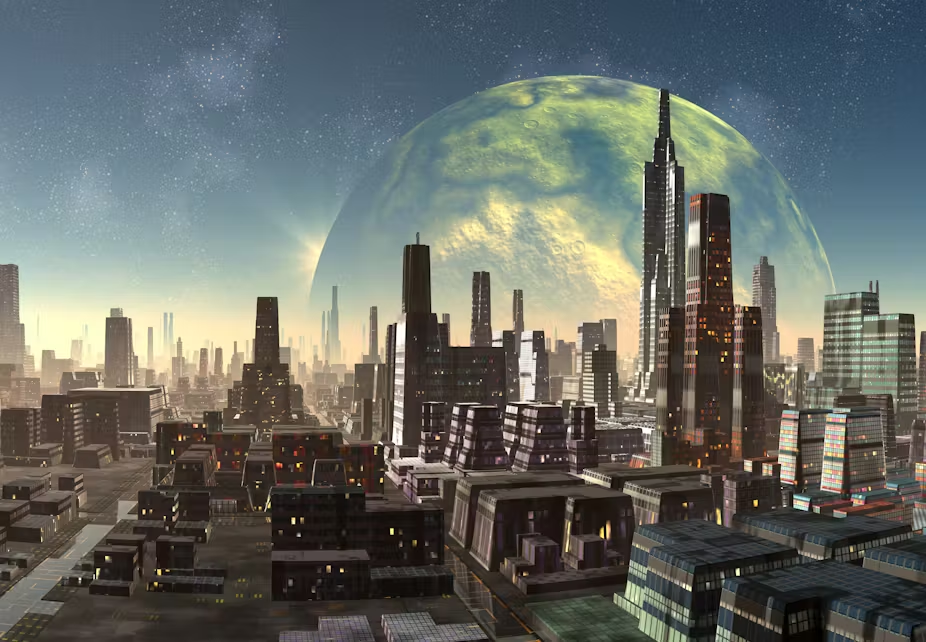In the soft luminescence of dawn, the city stretches awake, its skyline a testament to the dreams of countless visionaries. Steel and glass reach skyward, reflecting the pink-orange hues of the morning sun, signaling the beginning of another day in a world where urban landscapes are continuously reborn. This is not just any city; this is the city of the future—a dynamic symphony of innovation, technology, and humanity.
The Blueprint of Tomorrow
As one stands at the precipice of this new era, the architectural ethos of cities has shifted dramatically. No longer confined by the materials that dominated the 20th century, future cities blend sustainability with technology, creating environments where human aspirations and ecological responsibilities converge. Futuristic city maps reveal an intricate weave of green spaces, intertwining with bustling districts and quiet residential areas, all designed for minimal environmental impact and maximum human benefit.
One can imagine buildings that are not just structures but ecosystems—high-rises that produce more energy than they consume, walls that breathe, and windows that adjust to the light dynamically. The materials of these edifices are the products of revolutionary advances in science, featuring carbon-absorbing surfaces, self-healing concrete, and transparent aluminum.
Building the Unbuildable: The Rise of 3D Printing
The construction of such marvels is made possible by technologies that were once relegated to the realm of science fiction. Among these, 3D printing stands out as a cornerstone. Entire sections of cities are printed layer by layer, reducing construction waste to near zero and allowing for shapes and forms that traditional methods could never achieve. This 3D printed cityscape is not only a testament to human ingenuity but also a clear signal of our commitment to reducing the footprint of our habitats.
In Amsterdam, a prototype of a 3D-printed steel bridge has already demonstrated the capabilities and potential of additive manufacturing in urban architectural applications. This project not only showcases the practical applications of 3D printing in large-scale constructions but also highlights the aesthetic possibilities, blending functionality with an avant-garde elegance.
Integration of Nature and Technology
In the futuristic cityscape, the line between nature and built environments blurs. Rooftop gardens are no longer novelties but necessities, vital to the city’s air purification and heat regulation systems. Vertical farms rise alongside office towers, supplying fresh produce that travels only a few floors down to reach urban consumers, drastically reducing the food’s carbon footprint.
Singapore provides a real-life glimpse into this future with its Supertree structures and the integration of verdant oases throughout its urban areas. These initiatives not only enhance the quality of urban life but also serve as a model for cities worldwide, demonstrating that urban centers can be both lush and technologically advanced.
The Pulse of Urban Life: Smart Cities
Central to the lifeblood of these new metropolises are the smart technologies that power them. Streets are lined with sensors that manage traffic flow and optimize energy use, while AI-powered systems handle everything from emergency services to public transportation, making cities safer and more efficient.
In Barcelona, the implementation of comprehensive IoT systems across urban services has turned the city into one of the most data-driven in the world. Street lights adjust based on pedestrian traffic, and water usage is meticulously controlled to prevent waste, exemplifying how technology is used to harmonize city life.
A Vision Shared
The cities of the future are not built on technology alone but on the shared visions of their inhabitants. Community-driven design is paramount, where residents have a say in shaping their environment, ensuring that the city evolves to meet the needs of its people rather than dictating those needs.
Conclusion: A New Dawn for Urban Life
As the sun sets, bathing the city in alpenglow, one can’t help but feel a sense of wonder at the progress humanity has made. The cityscapes of the future, as envisaged today, promise a world where living in harmony with our planet is not only possible but natural. It’s a testament to human ingenuity and a constant reminder of our perpetual quest for improvement and a brighter, sustainable future for all.
In crafting cities that dream beyond the confines of the earth and reach for the stars, we mold a reality that was once confined to the canvas of our imaginations—a vivid, vibrant testament to the endless possibilities of human creativity.

